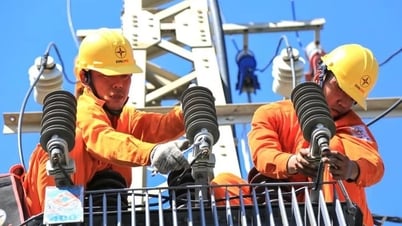
A group of international scientists led by the Institute of Deep-Sea Science of the Chinese Academy of Sciences (IDSSE) has just announced the discovery of rich ecosystems at depths of up to 9,533m in the Pacific Ocean , according to research results published in the journal Nature, reported by a Vietnam News Agency correspondent in Brussels.
According to the authors, these ecosystems were recorded in two ocean trenches, the Kuril-Kamchatka and Aleutian, which span more than 2,500km in the Northwest Pacific. This is the first time that biological communities at such depths and on such a large scale have been directly observed.
The survey was carried out using the manned submersible Fendouzhe, the deepest diving vehicle currently available.
Many of the organisms found here rely not on organic matter falling from the upper layers of the water but on “chemosynthetic” living, using energy from chemical reactions to fix carbon, rather than sunlight. Compounds such as methane or hydrogen sulfide are converted into energy by microorganisms.
The research team recorded the presence of red tubeworms, colorful bivalve mollusks, white worms with special body structures, and many other undescribed biological forms.
Analysis of the samples showed that methane at the sites was produced by deep-sea bacteria and accumulated in the sediments. This finding suggests that deep-sea trenches may be significant reservoirs of carbon in the form of methane, which have not been accounted for in global models.
Scientists say the study's results call for an assessment of the impact of deep-sea mining activities, which could have an impact on these unique ecosystems.
According to Dr Dominic Papineau, co-author of the study, this discovery opens up the possibility of similar environments existing in sub-ice oceans on celestial bodies such as Europa (Jupiter) or Enceladus (Saturn). He said that high pressure is not an absolute limit to life.
The research team believes that this discovery is just the beginning, and further surveys are needed in other deep-sea trenches to better understand the biodiversity and ecological functions of these extreme environments./.
Source: https://www.vietnamplus.vn/phat-hien-he-sinh-thai-da-dang-o-do-sau-9500m-duoi-day-thai-binh-duong-post1055979.vnp























![[Photo] Firmly marching under the military flag: Ready for the big festival](https://vphoto.vietnam.vn/thumb/1200x675/vietnam/resource/IMAGE/2025/8/15/86df2fb3199343e0b16b178d53f841ec)
![[Photo] Prime Minister Pham Minh Chinh attends a special art program called "Hanoi - From the historic autumn of 1945"](https://vphoto.vietnam.vn/thumb/1200x675/vietnam/resource/IMAGE/2025/8/15/c1c42655275c40d1be461fee0fd132f3)
![[Photo] Prime Minister Pham Minh Chinh talks on the phone with Cambodian Prime Minister Hun Manet](https://vphoto.vietnam.vn/thumb/1200x675/vietnam/resource/IMAGE/2025/8/15/72d3838db8154bafabdadc0a5165677f)



![[Photo] The special solidarity relationship between Vietnam and Cuba](https://vphoto.vietnam.vn/thumb/1200x675/vietnam/resource/IMAGE/2025/8/15/5f06c789ab1647c384ccb78b222ad18e)

![[Photo] Binh Khanh Bridge Ho Chi Minh City is ready to reach the finish line](https://vphoto.vietnam.vn/thumb/1200x675/vietnam/resource/IMAGE/2025/8/14/b0dcfb8ba9374bd9bc29f26e6814cee2)































![[Photo] President Luong Cuong receives Finnish Ambassador to Vietnam Keijo Norvanto](https://vphoto.vietnam.vn/thumb/402x226/vietnam/resource/IMAGE/2025/8/15/9787f940853c45d39e9d26b6d6827710)




































Comment (0)